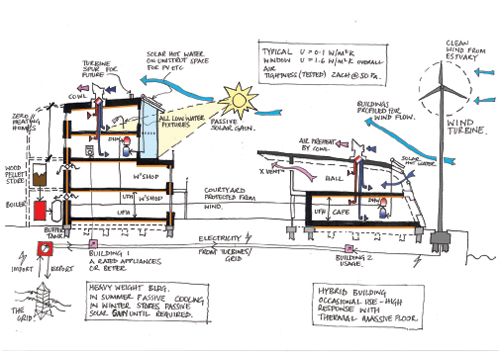Design for a Carbon-Free Life: The Pursuit of
Breaking Ground on Zero Carbon
One project that could become a model for future development is Solar 2, an 8,000-square-foot net-zero environmental learning center designed by the Brooklyn-based architects Kiss + Cathcart for the East River waterfront in New York City. The $12.5 million building, slated to open in 2009, will operate under the sponsorship of the Community Environmental Center (CEC), a not-for-profit energy-efficiency contractor.
By using the planned LEED Platinum building as a teaching tool, and through classes, lectures, exhibitions, and other public events, the CEC will educate New York City residents about renewable power and energy efficiency. For example, an "eco-apartment" will demonstrate energy-saving technologies appropriate for residential construction, such as dense pack insulation, compact fluorescent lighting, high-performance windows, and Energy Star appliances.
Because it is a learning model and a showcase, the architects will incorporate a variety of materials into the building envelope for demonstration purposes. While cautioning that Solar 2 is still in the schematic design phase, project architect Clare Miflin shared their plans. The structure will be steel with a high percentage of recycled content. One wall may be brick-clad, like a typical Manhattan apartment building, but with recycled newspaper as insulation. Another wall may be made with fiber-cement panels, with yet another in recycled aluminum. These sort of sustainable gestures are only the beginning of the project's comprehensive strategy for achieving zero-energy status.Â
Â
|
Â
Reaching for Zero
Architects and engineers say that reaching a zero-energy goal necessarily requires a much more integrated design process than is typical for a conventional building. "When energy use is not important, you engineer to meet the codes," says Fiona Cousins PE, a principal at Arup, Kiss + Cathcart's mechanical consultant on Solar 2. However, the interrelationship between systems and building envelope, for example, requires close collaboration among the various design disciplines. "If you set a low-energy goal, design has to be a team effort," she says.
he approach Arup developed for Solar 2, as well as for other low-energy projects, focuses on three main areas: load reduction, the thermal efficiency of the building envelope, and the power source. "The first thing we ask is how to reduce the loads," Cousins says. Arup runs whole-building simulations to analyze the potential for energy savings through incorporating lower-energy lamps, reducing the number of light fixtures, and specifying energy-efficient building systems. Low wattage fixtures will be installed throughout Solar 2 and the building's elevator will be 50 percent more efficient than conventional models. Some spaces will have carbon dioxide (CO2) monitors so that when there are fewer people in the building, the mechanical system will respond and decrease the intake of fresh air and thus reduce the amount of supply air that needs to be cooled or heated.










